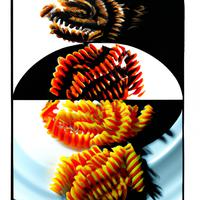
1 serving (85 grams) contains 300 calories, 10.0 grams of protein, 1.5 grams of fat, and 60.0 grams of carbohydrates.

Log this food in SnapCalorie

Nutrition Information
Calories |
600 | ||
|---|---|---|---|
% Daily Value* |
|||
| Total Fat | 3 g | 3% | |
| Saturated Fat | 0.6 g | 3% | |
| Polyunsaturated Fat | 0 g | ||
| Cholesterol | 0 mg | 0% | |
| Sodium | 20 mg | 0% | |
| Total Carbohydrates | 120.0 g | 43% | |
| Dietary Fiber | 6 g | 21% | |
| Sugars | 4.0 g | ||
| protein | 20 g | 40% | |
| Vitamin D | 0 mcg | 0% | |
| Calcium | 40 mg | 3% | |
| Iron | 4.0 mg | 22% | |
| Potassium | 200.0 mg | 4% | |
* Percent Daily Values are based on a 2,000 calorie diet. Your daily values may be higher or lower depending on your calorie needs.
Food Attributes
Source of Calories
About Tri-color rotini
Tri-Color Rotini is a vibrant twist on traditional pasta, loved for its curly, spiral shape and colorful appearance. Typically made from durum wheat semolina, the three colors—orange, green, and beige—come from added natural ingredients like tomato, spinach, and regular wheat flour. This pasta is popular in Italian cuisine and works beautifully in cold pasta salads, casseroles, or warm dishes with sauces. It provides a good source of carbohydrates for energy and contains small amounts of protein and fiber, depending on the brand. Whole wheat varieties offer enhanced nutritional benefits, such as more fiber and essential nutrients. While delicious and versatile, it’s best consumed in moderation due to its calorie density and potential lack of whole grains. Pairing tri-color rotini with lean proteins, fresh vegetables, and a light sauce can create well-balanced, nutritious meals suitable for varied diet plans.



